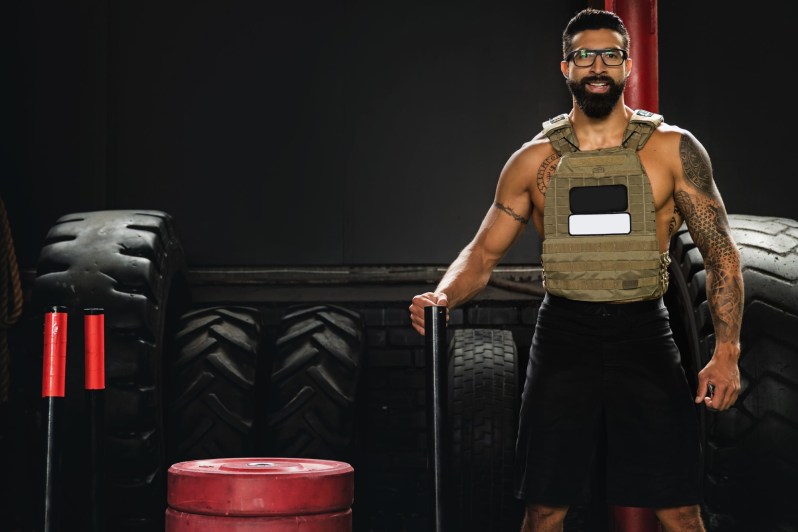Champion bodybuilder, seven-time Mr. Olympia winner, and busy Hollywood actor Arnold Schwarzenegger has always inspired us to stay in shape. He’s even coined his own exercise called the Arnold Press. If you’re short on time and you don’t feel like going to the gym, just like he said, Arnie is back again with a time-efficient 15-minute weighted rucksack workout.
With rucking still trending in the fitness world, this weighted rucksack workout is another way to keep things interesting and switch up your routine. Rucking involves walking or hiking while wearing a weighted rucksack, and Arnie has taken this trend to a whole new level. Let’s look at one of the latest worthy routines from this impressive, experienced powerlifter.
Arnie’s 15-minute weighted rucksack workout

Recently, Arnold shared another worthy workout in his Pump Club newsletter. All you need is two dumbbells and a weighted rucksack or vest. Arnie blends cardio with muscle-building moves and full-body strength training for a well-rounded workout.
Perform one set of each exercise for 30 seconds before taking a few breaths and repeating the move again. Power through as many rounds as you can in 15 minutes.
Bodyweight or dumbbell squat

Your quads take on the brunt of the work when it comes to the dumbbell squat. You’ll also target your hamstrings, glutes, abs, core, adductors, abductors, and calf muscles.
How to do a dumbbell squat:
- Stand with your feet a little wider than hip-width apart.
- Angle your toes slightly out.
- Hold two dumbbells in your hands with your arms down by your sides. Your palms should be facing your body.
- Keep your core engaged and your spine neutral, and focus straight ahead.
- Bend your knees to dip down into the squat while keeping the weights down at your sides.
- Ideally, you want your hips to be parallel with your knees.
- At the lowest point of your dumbbell squat, your elbows should touch the inside of your knees, and the dumbbells should be down by your ankles.
- Press down with the heels of your feet and lift yourself back up to the starting position.
- Repeat until you complete the set.
Bodyweight or weighted push-up

Pushups work your triceps in your arms, pecs in your chest, and deltoids in your shoulders. You’ll also work your core and leg muscles to help stabilize you. Wearing the weighted vest or rucksack levels up the challenge of this classic move.
How to do a pushup:
- Start on all fours with your hands about shoulder-distance apart.
- Extend your legs back behind you so your spine and legs form a straight line, and your knees and hips are in the plank position.
- Lower yourself down until your chest touches the floor and your elbows are at a 90-degree angle.
- Push yourself back up to straighten your arms.
- Repeat until you complete the set.
Overhead carry

The overhead carry is an excellent move for building shoulder and upper body strength and fine-tuning your balance and your ability to hoist objects overhead in a primal fashion.
How to do the overhead carry:
- Stand tall with an upright torso and engage your core.
- Press your weights or weighted rucksack overhead.
- Begin a fast march while carefully keeping the weights pressed overhead.
- March forward for 20 meters before returning to the starting position.
- Repeat until you complete the set.
Alternating lunges

For this move, you can wear the weighted rucksack or hold the dumbbells, or both if you’re up for the challenge. With alternating lunges, you alternate your legs to get your muscles moving and perfect your lunge technique. This move merges strength training with cardiovascular fitness.
Make sure you have enough room to take wide strides.
Here’s how to do alternating lunges:
- Stand with your torso upright and your feet about shoulder-width apart.
- Engage your core and keep your gaze straight ahead.
- You can place your hands on your hips or let your arms hang down by your sides.
- Step forward with your right foot so it’s about two feet in front of you.
- Plant your right foot firmly on the ground in front of you and allow your left heel to lift up naturally as you bend both knees.
- Lower your back knee down until it almost touches the ground in the lowest part of the lunge position.
- Press firmly down through your right heel and start straightening your legs to bring yourself back to stand while also swinging your left leg forward about two feet in front of you.
- Now, you can perform the lunge on the other side.
- With each lunge, continue alternating sides and stepping forward.
- When you’re ready to stop, make sure you’re balanced, and bring your back foot next to your front to stand up.
Dumbbell or weighted rucksack overhead press

The overhead press strengthens your triceps, shoulders, and traps in your back. You’ll also engage your pecs in your chest and your abdominal muscles.
How to do the dumbbell overhead press:
- Stand upright and straighten your back.
- Hold a dumbbell in each hand, at your shoulders, with an overhand grip. Keep your thumbs on the inside and knuckles face up.
- Exhale as you straighten your arms and raise the weights above your head with control.
- Pause briefly at the top and inhale as you return the dumbbells to your starting position.
- Repeat until you complete the set.




